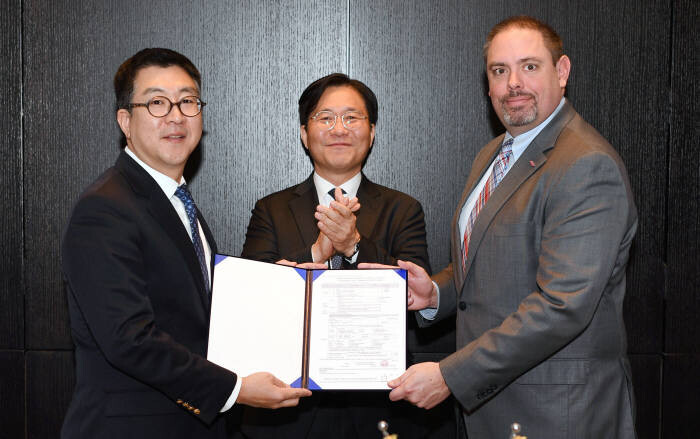hankyoreh
Links to other country sites 다른 나라 사이트 링크
DuPont to establish EUV photoresist factory in S. Korea

The global chemical company DuPont is establishing an extreme ultraviolet (EUV) photoresist production factory in South Korea. EUV photoresists are among three key semiconductor materials for which Japan impose controls on exports to South Korea in July of last year.
In a meeting in Silicon Valley on Jan. 8, DuPont Electronics and Imaging President Jon Kemp and South Korean Minister of Trade, Industry and Energy Sung Yun-mo “finalized plans for investment in South Korea to build EUV photoresist development and production facilities and submitted an investment report to [the Korea Trade-Investment Promotion Agency] KOTRA,” the Ministry of Trade, Industry and Energy (MOTIE) announced on Jan. 9.
The investment report quoted a total of US$28 million. DuPont’s plan is to use its South Korean affiliate Rohm and Haas Electronic Materials Korea to establish an EUV photoresist production line at its factory in Cheonan, Gyeonggi Province, which has been producing semiconductor circuit board materials and components since 1998. Photoresists are materials used to create circuits through chemical changes that occur upon exposure to light after the material has been placed on a semiconductor’s silicon wafer. The EUV process using EUV photoresists in particular is seen as a key next-generation technology.
To date, South Korea has relied on Japanese imports for over 90% of photoresists. But DuPont’s investments in EUV photoresist production in South Korea suggest the diversification of supply sources to include the US and Europe is likely to speed up. Photoresists were the only category of the three key materials for which Japan relaxed its controls last December, granting “specific blanket permits” instead of individual permits. Its move was seen as reflecting concerns about the potential blow to Japanese businesses if South Korea adopted new importation sources for the items.
During the submission of the investment report, Kemp announced plans to “work very closely” for the development and production of EUV photoresists, including product testing with major demand businesses in South Korea.
Sung said, “While there has been some progress recently in resolving Japan’s export control measures -- including the Japanese government’s decision to allow special blanket permits for EUV photoresists -- this cannot be seen as a fundamental resolution approach.”
“The South Korean government will continue pursuing efforts to establish technology competitiveness for key materials, components, and equipment and diversify its supply lines,” he added.
Sung also presided over a Jan. 9 Silicon Valley roundtable event for US investors interested in investing in South Korea. Representatives from 10 companies in the areas of semiconductors, automobiles, the hydrogen economy, renewable energies, information technology, and venture capital were invited to hear an explanation of the South Korean government’s hydrogen economy promotion road map and measures to strengthen competitiveness for key materials, components, and equipment, as well as its support policies to attract investment in South Korea.
By Kim Eun-hyoung, staff reporter
Please direct comments or questions to [english@hani.co.kr]

Editorial・opinion
![[Editorial] Yoon must halt procurement of SM-3 interceptor missiles [Editorial] Yoon must halt procurement of SM-3 interceptor missiles](https://flexible.img.hani.co.kr/flexible/normal/500/300/imgdb/child/2024/0501/17145495551605_1717145495195344.jpg) [Editorial] Yoon must halt procurement of SM-3 interceptor missiles
[Editorial] Yoon must halt procurement of SM-3 interceptor missiles![[Guest essay] Maybe Korea’s rapid population decline is an opportunity, not a crisis [Guest essay] Maybe Korea’s rapid population decline is an opportunity, not a crisis](https://flexible.img.hani.co.kr/flexible/normal/500/300/imgdb/original/2024/0430/9417144634983596.jpg) [Guest essay] Maybe Korea’s rapid population decline is an opportunity, not a crisis
[Guest essay] Maybe Korea’s rapid population decline is an opportunity, not a crisis- [Column] Can Yoon steer diplomacy with Russia, China back on track?
- [Column] Season 2 of special prosecutor probe may be coming to Korea soon
- [Column] Park Geun-hye déjà vu in Yoon Suk-yeol
- [Editorial] New weight of N. Korea’s nuclear threats makes dialogue all the more urgent
- [Guest essay] The real reason Korea’s new right wants to dub Rhee a founding father
- [Column] ‘Choson’: Is it time we start referring to N. Korea in its own terms?
- [Editorial] Japan’s rewriting of history with Korea has gone too far
- [Column] The president’s questionable capacity for dialogue
Most viewed articles
- 1Months and months of overdue wages are pushing migrant workers in Korea into debt
- 2Trump asks why US would defend Korea, hints at hiking Seoul’s defense cost burden
- 3At heart of West’s handwringing over Chinese ‘overcapacity,’ a battle to lead key future industries
- 4[Editorial] Yoon must halt procurement of SM-3 interceptor missiles
- 5Fruitless Yoon-Lee summit inflames partisan tensions in Korea
- 6AI is catching up with humans at a ‘shocking’ rate
- 7Dermatology, plastic surgery drove record medical tourism to Korea in 2023
- 81 in 3 S. Korean security experts support nuclear armament, CSIS finds
- 946% of cases of violence against women in Korea perpetrated by intimate partner, study finds
- 10Amnesty notes ‘erosion’ of freedom of expression in Korea in annual human rights report